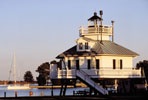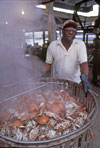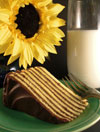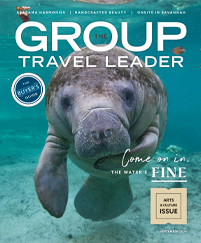During the War of 1812, St. Michaels, Md., was on a list of towns to burn as the British fleet sailed up the Chesapeake Bay on its way to Washington and Baltimore. The townsfolk had other ideas.
“They were prepared. They hung lanterns in treetops, and the British thought the town was built on a hilltop and overshot the entire town,” said Kelley Cox, co-owner of Dockside Express, which operates tours of the area. “They didn’t burn one house down.”
 |
| The 1879 Hooper Strait Lighthouse, a rare screwpile lighthouse, is on diplay at the Chesapeake Bay Maritime Museum in Cambridge, which tells about the Eastern Shore’s maritime history and culture. Courtesy Maryland Office of Tourism Development |
St. Michaels became known as the “town that fooled the British.” Today, Maryland’s Eastern Shore, the 200-mile-long peninsula between the Chesapeake Bay and the Atlantic Ocean where St. Michaels is located, is an off-the-beaten-path destination that surprises visitors with its laid-back pace; small-town charm; rich maritime heritage; locally owned shops, art galleries and boutiques; and diverse and delicious dining options.
“It’s an amazing thing. People go up and down I-95 and have not the slightest idea we are here. It gives you a sense of surprise. People are totally stunned,” said Wayne Hill of Hill Travel Centre in North East, Md., who leads tours that focus on the area’s small towns.
“We’re unique,” said Cox. “We are quite a few years behind the rest of the world. We go at our own pace. This is a place where you can just relax and watch the boats go by.”
“High blood pressure doesn’t normally exist here,” said Hill.
Maritime heritage
One of the distinctive features of the Eastern Shore that is an eye opener for many visitors is its long and extensive maritime heritage that dates back centuries.
“Unless you have really grown up in a fishing village, you don’t understand the culture here,” said Cox. “It is how people make a living. My father was a waterman, and I grew up in a waterman’s family. We tell how it is and show the traditional ways of catching crabs.”
Cox’s company is based in Tilghman, a traditional fishing village located on an island near St. Michaels. Tours include a cruise around the island; a look at Chesapeake Bay skipjacks, the only commercial sailing fleet in North America; and visits to a crab wholesaler to see the process of separating the sooks, or females, from the jimmies, or males, and a crabmeat-picking demonstration.
 |
| Groups can see just steamed crabs during a tour of J.M. Clayton Co. in Cambridge, which sits on the Cambridge River. Courtesy Dorchester County Tourism |
Hill’s trips include a tour of J.M. Clayton, a 119-year-old crab house in Cambridge in the southern section.
“It shows the crabs coming in, how they [workers] separate the male and female, where they [crabs] are steamed and then cooled overnight,” he said. “They [visitors] then go through swinging double doors in the next building, and the next thing you know, you are looking at 50 people picking crabs like hell. It’s amazing. If you don’t see it, you miss the flavor of the area.”
Several museums on the Eastern Shore also provide insight into the region’s maritime culture. The largest and most comprehensive is the Chesapeake Bay Maritime Museum on 18 waterfront acres in St. Michaels.
Its 10 exhibit buildings trace the geological, social and economic history of the Chesapeake Bay, and its large collection of watercraft features a skipjack, crabbing skiffs, workboats, log canoes and one-design boats.
Other museums worth checking out are the C&D Canal Museum in Chesapeake City, the Ward Museum of Wildfowl Art in Salisbury, the Richardson Maritime Museum and Boatworks in Cambridge and the Ocean City Life-Saving Station Museum.
Small towns are big draws
“The No. 1 reason people come here is the water,” said Debbi Dodson, director of the Talbot County Office of Tourism. “The second is the small-town charm.”
Starting at the northern end of the peninsula, here is a sampling of some of the area’s small towns.
Near the northern terminus of Chesapeake Bay, Chesapeake City is located on the banks of the Chesapeake and Delaware Canal, a 14-mile canal dating to 1829 that connects the bay with the Delaware River.
“It is extremely picturesque, with more than 100 beautiful restored homes and a couple of lovely restaurants,” said Hill. “The tour boat, Miss Claire, takes half-hour to hour cruises on the canal. It is fascinating to be out there and see one of these giant freighters come through.”
 |
| Smith Island Cake, with frosting between each of nine layers of cake, is Maryland’s official dessert. Courtesy Somerset County Tourism |
Chestertown, on the Chester River, has many Colonial-era homes, bay cruises aboard the replica 18th-century Schooner Sultana and Washington College, the 10th-oldest college in the United States.
Rock Hall, a 400-year-old waterman community, sits on the bay, and the town beach provides a sweeping view of the Chesapeake Bay. After viewing the bay and the Eastern Neck National Wildlife Refuge outside town, stop at Durding’s Store for homemade ice cream at the original 19th-century marble-top soda fountain.
Easton, the Colonial Capital of the Eastern Shore, has a number of antique shops, the restored art-deco Avalon Theater and a small cathedral that Hill says looks like “something in a European city.”
Oxford, which sits on a small peninsula, was the original port of entry for British trade vessels during Colonial times, and it has a replica of the original customs house. Hill said the ferry across the Tred Avon River to Bellevue is the oldest continuously operating ferry in the United States, dating to the late 1600s.
Crabby is good
And no trip to the Eastern Shore would be complete without a seafood meal. Rich Gilbert, sales and marketing specialist for the Maryland Office of Tourism Development, said the options range from the Red Roast, a converted chicken coop in Whitehaven, where “people bang little crab hammers instead of clapping” to the Wednesday-night band, to places in St. Michaels that “will do chef cooking demonstrations and bring in a wine coach for different wine pairings.”
 |
| Chesapeake City, with its quaint stores and flag-lined streets, is typical of the small town charm of the Eastern Shore. Courtesy Wilcomico Co. CVB |
Hill and Cox both take groups to Harrison’s Chesapeake House in Tilghman.
“The crab cakes are very fresh. They process their own seafood,” said Hill. “Betty has been making them for 38 years. Everything is served family-style.”
Said Dodson, “Stop at the Robert Morris Inn in Oxford and have crab cakes.” “It’s mentioned in James Michener’s Chesapeake. He claimed they have the best crab cakes.”
And top it off with Maryland’s official dessert, Smith Island Cake, named for the quaint fishing island in the bay where it was developed. “You go over by boat from Crisfield,” said Gilbert. “They feed you family-style at a sit-down lunch, and you walk around the island known for this cake. It is pretty much like a stack cake, with thin layers with frosting between each layer.”
That also describes the multilayered Eastern Shore, with its rural, small-town, maritime, shopping and dining layers that you can peel away one at a time.










